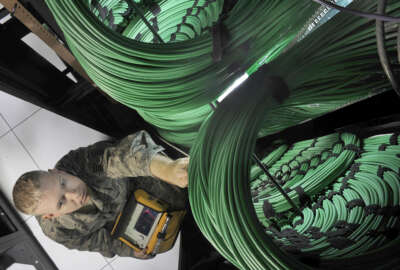
Air Force to expand number of bases with 5G, offers details on current experiments
The Air Force is getting ready to expand the number of bases where it wants to install and test 5G capabilities.
The Air Force is getting ready to expand the number of bases where it wants to install and test 5G capabilities. Frank Konieczny, Air Force chief technology officer, said there’s already been a leasing opportunity for 10 bases in the southeast region of the U.S., and that a new one is coming for 20 bases in the northwest. He also offered glimpses into what those experiments look like.
“So as we do this, the vendor has to come across and say they will provide service for all the bases that we have in the cluster. They also have to have ability to accelerate to 5G at some point in time and give us the scheduling points,” Konieczny said at a July 15 GovExec webinar about the future of 5G. “And they also have to tell us that we give them areas that they must cover with all the bases. So the award of the opportunity is basically to tell us exactly what they’re going to do and we give them a 25-year lease, which is to give them the return on investments necessary to support them even going to the bases which are far away that nobody really wants to be at.”
Some of the experiments the Air Force is conducting include spectrum sharing with commercial entities, because Konieczny said the government wants to start selling off the spectrum, which some weapons systems currently use. Right now, Hill Air Force base is experimenting with the lower, wider end of the spectrum, which is used by radar and aircraft. Meanwhile, Tinker Air Force base will soon begin experimenting with sharing the higher, more condensed end of the spectrum, which is the part of the spectrum where most commercial interests lie, Konieczny said.
Another experiment, currently taking place at Nellis Air Force base, which was added to the list of bases in May, involves developing mobile capabilities for Air Operations Centers.
“Basically, what they would want to do was to show how you can take an Air Operation Center, which consists of like 20-30 applications that are currently all in a room, move them into a distributed mobile environment where they can move, and people can work on those applications in various locations, while those locations are actually moving, and actually look like they’re actually sitting in the same room,” Konieczny said.
And at Hickam Air Force base, he said the Air Force wants to test the capabilities of 5G to enable direct data transfer on the performance and maintenance of the aircraft immediately during the landing process.
“This is at the edge. We’re going to use this data at the edge at the depots, as opposed to moving it any place else,” Konieczny said. “So the idea is as an aircraft lands — before it even lands, while it’s landing — all the information is pulled off. In 5G that’s theoretically feasible to actually do that. It’s fast enough.”
This is part of the push to develop smart depots using 5G technology. Everything would have internal 5G networks, he said, essentially a collection of mini-clouds. This would be coupled with new types of Internet of Things devices, which would gather the necessary data.
“All this is involved with some technology experiments we’re actually doing with IoT devices right now, because a lot of the IoT devices that we have are stupid, I mean really stupid. They’re really old, they’re really stupid,” Konieczny said. “And so we’re trying to figure out, can we add some hardware to these devices to make them secure and so we have an authentication capability from devices, as well as for adding new IoT sensors to do things that never had a sensor before, like motors.”
For example, he said DoD currently has a Small Business Innovation Research award out for sensors that not only monitor the state of the motor and transmit that data using 5G, but would also actually be powered by the vibration and heat of the motor itself, bypassing the need for additional electrical capabilities.
He also briefly discussed other uses for 5G, including augmented reality. For example, a mechanic working on an engine might be able to call a manufacturer and share images of the engine in real time as he worked on it, rather than trading emails with static images back and forth. There’s also the potential for real-time simulation training from separate locations, which currently requires too much bandwidth to accomplish.
But security is always a concern with these initiatives, both from a cyber perspective and from a supply chain perspective. Konieczny said the two main vulnerabilities are the endpoints, which have to be hardened and authenticated, and the presence of equipment that is not American-manufactured.
The Federal Acquisition Regulatory Council recently implemented a new rule prohibiting agencies from buying products or services from companies which use Huawei, ZTE or other prohibited products from Chinese companies. But Congress is still concerned about Huawei’s 5G architectures in host countries, and wants a report from DoD on the risk to personnel, equipment and operations.
“You’ve got to think of this as technology; it’s not a panacea of everything,” Konieczny said. “So don’t assume that everything is going to work amazingly well tomorrow. It’s going to be an evolution step. And I think people have to realize that 5G is not going to be instantaneously the best thing in the world.”
Copyright © 2024 Federal News Network. All rights reserved. This website is not intended for users located within the European Economic Area.
Daisy Thornton is Federal News Network’s digital managing editor. In addition to her editing responsibilities, she covers federal management, workforce and technology issues. She is also the commentary editor; email her your letters to the editor and pitches for contributed bylines.
Follow @dthorntonWFED
Related Stories





